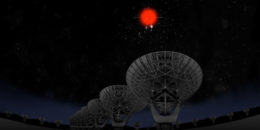How frequently do fast radio busts occur in the observable universe? Two researchers have now developed a new estimate.
Extragalactic Signals
In 2007, scientists looking through archival pulsar data discovered a transient radio pulse — a flash that lasted only a few milliseconds. Since then, we’ve found another 22 such “fast radio bursts” (FRBs), yet we still don’t know what causes these energetic signals.

Artist’s illustration of the Very Large Array pinpointing the location of FRB 121102. [Bill Saxton/NRAO/AUI/NSF/Hubble Legacy Archive/ESA/NASA]
Is FRB 121102 typical? How frequently do such bursts occur, and how frequently can we hope to be able to detect them in the future? And what might these rates tell us about their origins? Two scientists from the Harvard-Smithsonian Center for Astrophysics, Anastasia Fialkov and Abraham Loeb, have now taken a phenomenological approach to answering these questions.
Influencing Factors
Fialkov and Loeb argue that there are three main factors that influence the rate of observable FRBs in the universe:
- The spectral shape of the individual FRBs
FRB 121102 had a Gaussian-like spectral profile, which means it peaks in a narrow range of frequencies and may not be detectable outside of that band. If this is typical for FRBs, then signals of distant FRBs may become redshifted to outside of the frequency band that we observe, making them undetectable. - The FRB luminosity function

FRB detection rates in the 1.25–3.5GHz band predicted by the authors’ models (red and blue solid and dashed lines), as a function of the flux limit for detection (top) and as a function of the FRB host’s redshift (bottom). Grey circles mark our detections of FRBs thus far. [Fialkov & Loeb 2017]
FRBs may all have the same intrinsic brightness (like Type Ia supernovae, for instance). Alternatively, there may be many more faint and dim FRBs than bright ones (like the distribution of galaxy luminosities). This difference affects the number of FRBs we could detect. - The host galaxy population
Are FRBs most commonly hosted by low-mass galaxies like FRB 121102? Or do they occur in high-mass galaxies as well? This affects the number of FRBs we would expect to observe at different redshifts.
Future Hope
By exploring a range of models that vary these three factors, Fialkov and Loeb find estimates for the rate of FRBs that would appear in the 500 MHz–3.5 GHz frequency band probed by observatories like Parkes, Arecibo, and the Australian Square Kilometre Array Pathfinder (ASKAP).
Fialkov and Loeb find that, when we account for faint sources, one FRB may occur per second across the sky in this band. The authors show that future low-frequency radio telescopes with higher sensitivity, such as the Square Kilometre Array, should be able to detect many more of these sources, helping us to differentiate between the models and narrow down the properties of the bursts and their hosts. This, in turn, may finally reveal what causes these mysterious signals.
Citation
Anastasia Fialkov and Abraham Loeb 2017 ApJL 846 L27. doi:10.3847/2041-8213/aa8905


6 Comments
Pingback: FRBs every second?
Pingback: Fast Radio Bursts: Mystery Solved? – ASTROCOHORS
Pingback: Fast Radio Bursts: Mystery Solved? | Raket Science
Pingback: 7 Mysteries Science Hasn’t Solved – Broadcast
Pingback: 7 Mysteries Science Hasn't Solved - Bitinvader
Pingback: 7 Mysteries Science Hasn't Solved | VideoPure.info